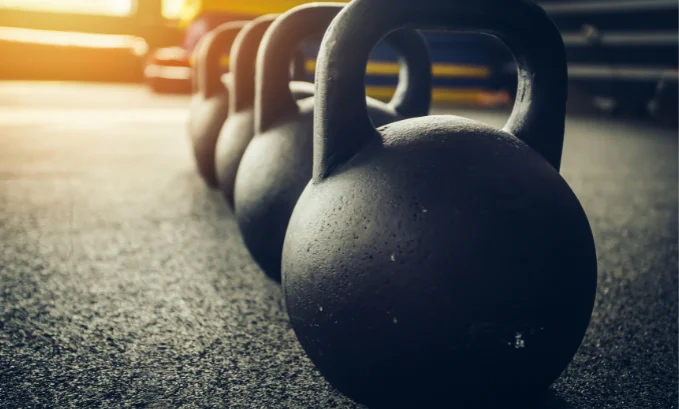Today is Fitness Friday! On Fridays, we seek to provide you with up-to-date conversations surrounding personal fitness and exercise routines, as well as techniques that we believe will boost your performance, inside the gym and out!
Today’s subject is the kettlebell! For some, hoisting heavy weights and grunting in the gym is not their definition of a good time. Where bodybuilders enjoy training for aesthetics and powerlifters for sheer strength, you might find yourself enjoying a different variety of lifting—more functional—without the “gym-timidation”.
Dating back to the late 19th century in Russia/Europe, kettlebells have long been used in recreational and competitive strength athletics. Not only are kettlebells a fun and unique way to mix up your workouts, but they also offer a range of benefits that traditional strength training can’t match.
Here are five reasons why you might want to trade in your barbells for kettlebells:
• Improved cardiovascular endurance: Kettlebell workouts involve dynamic, whole-body movements that get your heart rate up and improve your cardiovascular endurance. A study published in the Journal of Strength and Conditioning Research found that a 20-minute kettlebell workout was just as effective at improving cardiovascular endurance as a 20-minute treadmill run.
• Increased strength and power: Kettlebell exercises such as swings, snatches, and cleans require explosive power and strength, making them ideal for building muscle and increasing power. A study published in the Journal of Strength and Conditioning Research found that kettlebell training resulted in significant increases in strength and power in both upper and lower body muscles. And let’s be real, who doesn’t want to be able to swing a heavy weight around like it’s nothing?
• Improved mobility and flexibility: Kettlebell exercises often involve a range of motion and functional movements that can improve flexibility and mobility. So not only will you get stronger, but you’ll also become more limber and agile. A study published in the Journal of Strength and Conditioning Research found that kettlebell training resulted in significant improvements in hip and shoulder flexibility.
• Enhanced functional fitness: Kettlebell exercises mimic everyday movements and activities, making them great for improving functional fitness and coordination. A study published in the Journal of Strength and Conditioning Research found that kettlebell training resulted in significant improvements in balance, coordination, and functional fitness. No more stumbling around like a drunken sailor!
• Kettlebells are just plain cool: Let’s be real, there’s something undeniably cool about being able to swing a heavy weight around with ease. Plus, they come in all sorts of fun colors and sizes, so you can personalize your kettlebell collection to your heart’s desire.
There are four main styles of kettlebell lifting: the hardstyle, the ballistic, the grind, and the flow. The hardstyle focuses on proper form and technique, with a focus on developing strength, stability, and power. Exercises in this style typically involve slow, controlled movements. The ballistic style involves explosive, dynamic movements that require speed and power.
Exercises in this style include swings, snatches, and cleans. The grind style involves slow, controlled movements that focus on building strength and endurance in specific muscle groups. Exercises in this style include goblet squats and Turkish get-ups. The flow style involves linking kettlebell exercises together in a seamless, flowing sequence. This style emphasizes coordination, balance, and mobility. Each style has unique benefits and can be incorporated into a well-rounded kettlebell training program. It’s important to choose the style that best aligns with your fitness goals and preferences.
Kettlebells have a range of benefits including improved cardiovascular endurance, increased strength and power, improved mobility and flexibility, enhanced functional fitness, and just plain being cool. There also exists a variety of styles for you to practice -inside the gym and out. So why not give kettlebells a try and see how they can enhance your training routine? Until next time…
Ryan Alvarez
References
- Kettlebell Swing vs. Treadmill Running: Acute Physiological and Performance Responses. (2016). Journal of Strength and Conditioning Research, 30(1), 245-250.
- The Effect of Kettlebell Training on Strength, Power and Body Composition. (2010). Journal of Strength and Conditioning Research, 24(4), 1150-1155.
- The Effect of Kettlebell Training on Flexibility and Physical Function. (2012). Journal of Strength and Conditioning Research, 26(5), 1353-1358.
- The Effect of Kettlebell Training on Balance, Coordination. Flex
Wikimedia Foundation. (2022, September 19). Kettlebell. Wikipedia. Retrieved December 16, 2022, from https://en.wikipedia.org/wiki/Kettlebell








